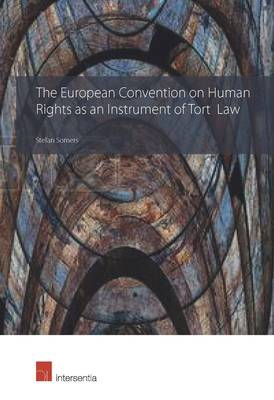
- Afhalen na 1 uur in een winkel met voorraad
- Gratis thuislevering in België vanaf € 30
- Ruim aanbod met 7 miljoen producten
- Afhalen na 1 uur in een winkel met voorraad
- Gratis thuislevering in België vanaf € 30
- Ruim aanbod met 7 miljoen producten
Zoeken
The European Convention on Human Rights as an Instrument of Tort Law
Stefan Somers
Hardcover | Engels
€ 132,95
+ 265 punten
Omschrijving
Tort law and human rights belong to different areas of law, namely private and public law. Nevertheless, the European Convention on Human Rights increasingly influences national tort law of signatory states, both on the vertical level of state liability and on the horizontal level between private persons.
An individual can appeal to the European Convention on Human Rights in order to challenge national tort law in two situations: where he is held accountable under national tort law for exercising his Conventions rights, and where national law does not provide effective compensation in accordance with Article 13. The second method is strongly connected with the practice of the European Court of Human Rights to award compensations itself on the basis of Article 41. A compensation in national tort law is considered to be effective according to Article 13 when it is comparatively in line with the compensations of the European Court of Human Rights granted on the basis of Article 41. This raises the important question as to how compensations under Article 41 are made by the European Court of Human Rights. The European Convention on Human Rights as an Instrument of Tort Law examines the entanglement of public and private and national and transnational law in detail and argues that while the Court uses a different terminology, it applies principles that are very similar to those of national tort law and that the Court has developed a compensatory practice that can be described as a tort law system. Stefan Somers is a professor at the Free University of Brussels (VUB) where he lectures on the law of obligations. He is also a trainee judge and prosecutor at the Court of First Instance and the Commercial Court, Antwerp.Specificaties
Betrokkenen
- Auteur(s):
- Uitgeverij:
Inhoud
- Aantal bladzijden:
- 372
- Taal:
- Engels
Eigenschappen
- Productcode (EAN):
- 9781780686837
- Verschijningsdatum:
- 29/10/2018
- Uitvoering:
- Hardcover
- Formaat:
- Genaaid
- Afmetingen:
- 155 mm x 231 mm
- Gewicht:
- 635 g

Alleen bij Standaard Boekhandel
+ 265 punten op je klantenkaart van Standaard Boekhandel
Beoordelingen
We publiceren alleen reviews die voldoen aan de voorwaarden voor reviews. Bekijk onze voorwaarden voor reviews.











